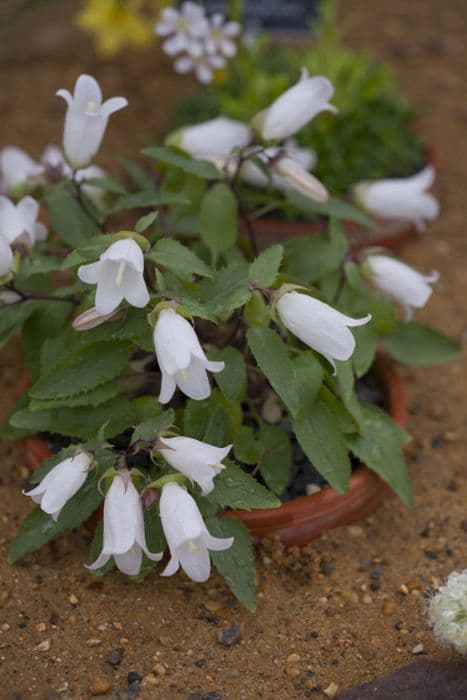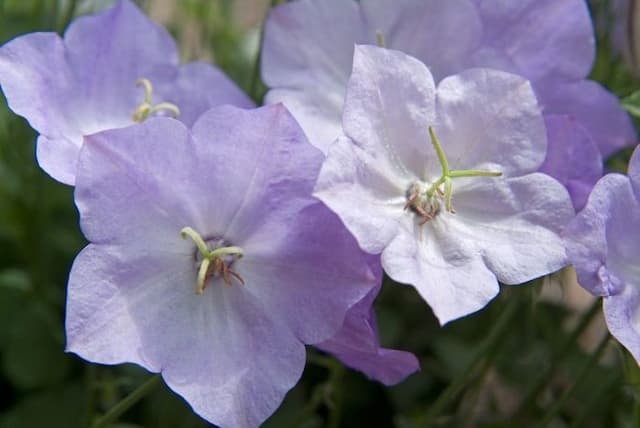Fan Lobelia Lobelia × speciosa 'Fan Orchidrosa' (Fan Series)

ABOUT
The Lobelia 'Fan Orchidrosa', part of the Fan Series, is a striking plant that boasts a lush foliage and an impressive display of blooms. The leaves are typically green, providing a dense backdrop for the flowers. The blossoms themselves are a standout feature, exhibiting a rich blend of colors that may include shades of pink, violet, and magenta. The flowers are tubular and have two lips; the upper lip is split into two lobes while the lower lip has three, giving the blooms a delicate, orchid-like appearance that is refined and elegant. The petals may have a sheen to them, catching the light and adding to the visual interest of the plant. These vivid flowers are typically densely packed, forming a showy spike-like inflorescence that rises gracefully above the foliage, making it an attractive option for gardens or as a statement plant in outdoor spaces. Its vibrant color and unique bloom structure make it a favorite among gardeners looking for plants that provide visual impact without needing to rely on their size.
About this plant
 Names
NamesFamily
Campanulaceae
Synonyms
Hybrid Lobelia, Fan Lobelia
Common names
Lobelia × speciosa 'Fan Orchidrosa' (Fan Series).
 Toxicity
ToxicityTo humans
Lobelia, including the Fan Orchidrosa variety, contains several alkaloids such as lobeline which can be toxic if ingested in large quantities. The symptoms of Lobelia poisoning can include nausea, vomiting, diarrhea, cough, dizziness, tremors, and potential respiratory failure in severe cases. Depending on the amount ingested, these symptoms can range from mild to severe. It's important to treat Lobelia with care and consult a medical professional if ingestion occurs.
To pets
For pets, Lobelia is similarly toxic as it is to humans. The primary toxic compound, lobeline, can cause symptoms such as excessive drooling, vomiting, diarrhea, and possibly more severe symptoms such as tremors, seizures, or difficulty breathing if ingested in substantial amounts. Pet owners should keep Lobelia plants out of reach of their animals and seek veterinary attention immediately if they suspect their pet has ingested part of the plant.
 Characteristics
CharacteristicsLife cycle
Perennials
Foliage type
Deciduous
Color of leaves
Green
Flower color
Pink
Height
2-3 feet (60-91 cm)
Spread
1-2 feet (30-60 cm)
Plant type
Herb
Hardiness zones
6
Native area
North America
Benefits
 General Benefits
General Benefits- Attracts pollinators: Lobelia × speciosa 'Fan Orchidrosa' is known for attracting bees, butterflies, and other beneficial insects to the garden, enhancing pollination.
- Aesthetic appeal: The plant adds visual interest with its striking flowers, contributing to the overall beauty of gardens and landscapes.
- Versatility: It can be used in a variety of garden settings, including borders, containers, and water margins, due to its adaptable nature.
- Low maintenance: Once established, it requires minimal care beyond regular watering and occasional feeding, making it suitable for gardeners of all levels.
- Long blooming period: The plant has a lengthy flowering season, which ensures continuous color in the garden for an extended period.
 Medical Properties
Medical PropertiesThis plant is not used for medical purposes.
 Air-purifying Qualities
Air-purifying QualitiesThis plant is not specifically known for air purifying qualities.
 Other Uses
Other Uses- Lobelia × speciosa 'Fan Orchidrosa' can be used as a natural dye, where the petals provide a unique hue to fabrics and arts.
- Garden photographers often utilize Lobelia as a subject to capture stunning macro photos due to its intricate flower structure.
- Lobelia flowers can be infused in oils to produce naturally scented oils for use in homemade candles and soaps.
- The plant is sometimes incorporated into educational programs about hybridization and cultivar development due to its cultivated origin.
- Beekeepers value Lobelia in gardens as a nectar source to create distinctive honey flavors.
- In art classes, Lobelia can be utilized for botanical drawing exercises due to its striking fan-shaped flowers.
- Decorative pressed flower crafts can benefit from the vibrant colors of Lobelia flowering petals.
- Culinary enthusiasts sometimes use the blooms as an exotic and edible garnish for salads, desserts, and cold dishes.
- Lobelia can serve as an indicator plant in gardens signaling the health of the environment, as its well-being often reflects local growing conditions.
- Rain gardens sometimes incorporate Lobelia since it can tolerate wet conditions and can play a part in sustainable landscaping practices.
Interesting Facts
 Feng Shui
Feng ShuiThe Lobelia is not used in Feng Shui practice.
 Zodiac Sign Compitability
Zodiac Sign CompitabilityThe Lobelia is not used in astrology practice.
 Plant Symbolism
Plant Symbolism- Uniqueness: The hybrid nature and intricate blossoms of Lobelia make it a symbol of uniqueness and distinction.
- Attractiveness: With its striking colors, Lobelia represents an eye-catching beauty that demands attention.
- Devotion: Lobelia often blooms with great fervor, which can symbolize deep passion and dedication in various aspects of life.
 Water
WaterCardinal flowers require evenly moist soil, so water regularly to keep the soil from drying out completely. It's best to water them deeply once or twice a week, providing about 1 to 1.5 gallons of water each time depending on weather conditions. During hot or windy periods, you may need to water more frequently to maintain consistent soil moisture. Make sure the water penetrates the soil rather than just wetting the surface to encourage deep root growth. Avoid overhead watering to minimize the risk of leaf diseases; instead, water at the base of the plant.
 Light
LightThe cardinal flower thrives best in partial shade, especially in the afternoon when the sunlight is most intense. A spot that offers morning sunlight with some dappled afternoon shade is ideal to protect the plant from excessive heat. Too much direct sunlight can cause stress and scorch the leaves, so be mindful of light exposure.
 Temperature
TemperatureCardinal flowers prefer a range of temperatures from 60 to 75 degrees Fahrenheit but can survive in temperatures as low as 50 degrees and as high as 90 degrees Fahrenheit. The ideal growing conditions include moderate to warm daytime temperatures with cooler nights.
 Pruning
PruningCardinal flowers benefit from pruning to encourage bushier growth and more blooms. Deadhead spent flowers regularly to promote continuous blooming throughout the season. Cut back the plants by about one-third after the first flowering to rejuvenate foliage and set new buds. The best time for major pruning is in late winter before new growth begins.
 Cleaning
CleaningAs needed
 Soil
SoilThe best soil mix for Cardinal Flower 'Fan Orchidrosa' is rich, moist, and well-draining, with an addition of compost or peat moss to improve fertility and moisture retention. The optimal soil pH for this hybrid Lobelia should be slightly acidic to neutral, ranging from 6.0 to 7.0.
 Repotting
RepottingCardinal Flower 'Fan Orchidrosa' grown in containers should be repotted every 1-2 years to refresh the soil and to accommodate root growth. Spring is the ideal time for repotting this Lobelia hybrid, ensuring it is ready for the growing season.
 Humidity & Misting
Humidity & MistingCardinal Flower 'Fan Orchidrosa' prefers moderate to high humidity levels but is adaptable to normal outdoor conditions. Striving for a humidity level of around 40-50% is usually sufficient to keep this hybrid Lobelia healthy and vibrant.
 Suitable locations
Suitable locationsIndoor
Place Lobelia 'Fan Orchidrosa' in bright, indirect light and keep soil moist.
Outdoor
Plant Lobelia 'Fan Orchidrosa' in part sun, moist soil, and mulch.
Hardiness zone
4-9 USDA.
 Life cycle
Life cycleLobelia × speciosa 'Fan Orchidrosa', commonly known as the Fan Lobelia, begins its life cycle when the seeds germinate in warm conditions after the last frost, usually in early spring. Seedlings emerge and develop into young plants with characteristic narrow, dark green leaves. Throughout the growing season, the plants grow rapidly and eventually produce tall spikes adorned with showy, orchid-like flowers that can range from pink to magenta, attracting pollinators to the garden. After flowering in the late summer to fall, the plant sets seed. The seeds are dispersed by wind or fall close to the parent plant for the next seasonal cycle. In winter, the plant typically dies back, with the roots or basal rosettes surviving in warmer climates to regenerate the following spring, or it may need to be treated as an annual in colder regions.
 Propogation
PropogationPropogation time
Spring to Summer
The most popular method of propagating Lobelia × speciosa 'Fan Orchidrosa', commonly known as the hybrid lobelia, is by division. This method is usually carried out in the spring before new growth starts. To propagate by division, carefully uplift the parent plant from the ground ensuring minimal root disturbance. Gently tease apart the clump into smaller sections, each with a portion of roots and shoots. Replant these divisions immediately into their new location or pots, ensuring they are kept well-watered and shaded until they establish. This technique allows gardeners to efficiently produce new plants that are true to the parent variety, rejuvenating older clumps and expanding their hybrid lobelia collections.









![Milky bellflower [Avalanche]](/_next/image?url=https%3A%2F%2Fplants-admin.emdemapps.com%2Fimages%2Fplants%2F%2Fimages%2F604b5dc88c1e7.png&w=640&q=75)